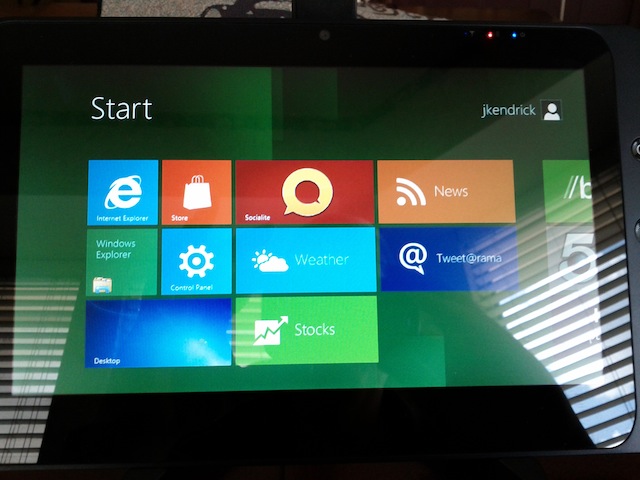Windows 8: First steps with the dual personality on tablets


The install of Windows 8 on the TegaTech v2 was very smooth. It struck me how much it looked like a Windows 7 install, which isn't surprising given the developers at Microsoft haven't had time to make it unique. I installed it from a USB stick, and after a brief period Metro was staring me in the face.
I do not intend to review Windows 8 (nor the install process) as it is just too new, and that would be pointless. I wasn't going to write about it at all, but after using it for a while the impression I am getting of one aspect of Windows 8 won't go away. When information about the dual nature of Windows 8 started hitting the web I was intrigued and wondered how Microsoft would pull that off. It seemed to me the Metro interface is slick and designed well, but bouncing back to the old Windows desktop was a bit strange.
I am finding the way Windows 8 bounces back and forth between the nice Metro interface and what is essentially the Windows 7 desktop to be jarring. It's hard to describe unless you do it on a touch tablet as I have been using. The Metro touch interface works well already, with the tiles nicely presented and the ease of swiping back and forth through the various start screens pleasantly done.
I like swiping from the side to get to common tasks, and love swiping between apps. I cannot envision how I would like the Metro interface on a "real" system, not a touch tablet, but on the slate it is a good implementation, although I need real apps to verify the experience.
The problem is that far too often tapping a Metro tile results in getting thrown back to the old Windows 7 desktop. This presented itself right from the beginning as my WiFi network wasn't working. This is a driver issue so I don't blame this early build of Windows 8 for that, but the way it was handled pointed out how new Windows 8 users are going to be hit in the face with the dual personality of the OS.
I swiped in the settings pane from the right, and saw that my network was disconnected. The only option given was to troubleshoot it, and tapping it on the nice green pane took me straight to the old desktop. It looked like Windows 7, worked like Windows 7, it was in fact the Windows 7 desktop. It wasn't very touch-enabled, either. I went from a tablet interface to a non-tablet interface with a single tap on the screen.
Dealing with the desktop mode on a Windows 8 tablet is just like using Windows 7 on one today. It's not very good. Things are small on the screen and hard to tap accurately, the same problem I've had with Windows 7 touch tablets for years.
I figured that this was a special case but throughout my use over the next few hours I kept finding myself thrown back and forth between Metro and the desktop far too often. Looking for a file? Tapping the File Manager Metro tile shoots you to the desktop. Working with the Control Panel in Metro? Hitting "More settings" bounces you into the old Windows 7 Control Panel. While nice to have options available, I found it jarring to be thrown back into the old OS far too often.
I kept thinking that if I was a new Windows 8 tablet owner, the excitement that comes with getting a new gadget would be dimmed when the realization set in that this is basically Windows 7 with a new skin. The more Windows 8 Metro bounced me back to the old desktop, the more that realization was driven home. I understand that there are lots of things under the hood that are new, but that's dashed every time that Windows 7 desktop takes over.
Microsoft has a big job ahead to make this dual personality work. My limited testing shows that the Metro interface is not natural to use with a mouse and keyboard, and the desktop mode doesn't work well with touch. It's like a one size fits all shirt that is far too big in the shoulders and far too tight around the waist. One size rarely fits all.
Related:
- Microsoft’s Windows 8 by the numbers
- Windows 8 unveiled
- Microsoft to developers: Metro is your future
- Microsoft’s Windows 8: Here’s what we now know (and don’t)
- Microsoft Build: Live blogging the Day 1 keynote
- Microsoft’s big task: Juggle PC, post-PC eras
- How will Windows 8 tablets stack up to the competition of the future?
- Windows Server 8: The Ultimate Cloud OS?
- Windows 8 will ship with built-in antivirus protection
- Windows 8 will run on old Atom CPUs and 1GB RAM
CNET: